Enriched Fresh Pasta with a Sea Bass By-Product, a Novel Food: Fatty Acid Stability and Sensory Properties throughout Shelf Life
Abstract
1. Introduction
2. Materials and Methods
2.1. Raw Material
2.2. Fish Concentrates Preparation
2.3. Preparation of Pasta
2.4. Proximal Analyses
2.5. Shelf Life Study for Enriched Fresh Pasta
2.5.1. Fatty Acid Profile
2.5.2. TBARS
2.5.3. Acidity Index
2.5.4. Health Indexes
2.6. Technological Properties
2.6.1. Optimal Cooking Time Estimation
2.6.2. Pasta Color
2.6.3. Cooking Losses
2.7. Sensory Analysis
2.8. Statistical Analyses
3. Results
3.1. Characterization of the Developed Pastas
3.2. Fatty Acid Profile throughout Storage Time
3.3. Ratios and Chemical Indices throughout Storage Time
3.4. Principal Components Analysis (PCA)
3.5. Optimal Cooking Time Estimation
3.6. Color Pasta
3.7. Cooking Losses
3.8. Sensory Profiles
4. Discussion
4.1. Characterization of the Developed Pastas
4.2. Fatty Acid Profile and Chemical Parameters
4.3. Technological Properties
4.4. Sensory Analysis
5. Conclusions
Author Contributions
Funding
Institutional Review Board Statement
Informed Consent Statement
Acknowledgments
Conflicts of Interest
References
- FAO. Reglamentación Técnico-Sanitaria para la Elaboración, Circulación y Comercio de Pastas Alimenticias; FAO: Rome, Italy, 1975. [Google Scholar]
- Sicignano, A.; Di Monaco, R.; Masi, P.; Cavella, S. From Raw Material to Dish: Pasta Quality Step by Step. J. Sci. Food Agric. 2015, 95, 2579–2587. [Google Scholar] [CrossRef] [PubMed]
- Ivkov, M.; Košutić, M.; Filipović, J.; Filipović, V. Spelt Pasta with Addition of Inulin as a Functional Food: Sensory Evaluation and Consumer Attitudes. Rom. Biotechnol. Lett. 2018, 23, 10. [Google Scholar]
- Frakolaki, G.; Giannou, V.; Topakas, E.; Tzia, C. Chemical Characterization and Breadmaking Potential of Spelt versus Wheat Flour. J. Cereal Sci. 2018, 79, 50–56. [Google Scholar] [CrossRef]
- Desai, A.; Brennan, M.A.; Brennan, C.S. The Effect of Semolina Replacement with Protein Powder from Fish (Pseudophycis Bachus) on the Physicochemical Characteristics of Pasta. Food Sci. Technol. 2018, 89, 52–57. [Google Scholar] [CrossRef]
- Kadam, S.U.; Prabhasankar, P. Marine Foods as Functional Ingredients in Bakery and Pasta Products. Food Res. Int. 2010, 43, 1975–1980. [Google Scholar] [CrossRef]
- Filipović, J.; Pezo, L.; Filipović, V.; Brkljača, J.; Krulj, J. The Effects of ω-3 Fatty Acids and Inulin Addition to Spelt Pasta Quality. Food Sci. Technol. 2015, 63, 43–51. [Google Scholar] [CrossRef]
- Italianfood.net—The Authentic Italian Food Platform. Available online: https://www.italianfood.net/ (accessed on 7 October 2020).
- Schuchardt, J.P.; Huss, M.; Stauss-Grabo, M.; Hahn, A. Significance of Long-Chain Polyunsaturated Fatty Acids (PUFAs) for the Development and Behaviour of Children. Eur. J. Pediatr. 2010, 169, 149–164. [Google Scholar] [CrossRef]
- EFSA Panel on Dietetic Products, Nutrition, and Allergies (NDA). Scientific Opinion on Dietary Reference Values for Fats, Including Saturated Fatty Acids, Polyunsaturated Fatty Acids, Monounsaturated Fatty Acids, Trans Fatty Acids, and Cholesterol. EFSA J. 2010, 8. [Google Scholar] [CrossRef]
- Babuskin, S.; Krishnan, K.R.; Saravana, P.A.; Sivarajan, M.; Sukumar, M. Functional Foods Enriched with Marine Microalga Nannochloropsis Oculata as a Source of W-3 Fatty Acids. Food Technol. Biotechnol. 2014, 52, 292–299. [Google Scholar]
- World Pasta Day 2019: Italy Lighting up the Way. Available online: https://news.italianfood.net/2019/10/24/world-pasta-day-2019-italy-lighting-up-the-way/ (accessed on 7 October 2020).
- De Bouillé, A.G.; Beeren, C.J.M. Sensory Evaluation Methods for Food and Beverage Shelf Life Assessment. In The Stability and Shelf Life of Food; Elsevier: Amsterdam, The Netherlands, 2016; pp. 199–228. [Google Scholar] [CrossRef]
- Giménez, A.; Ares, F.; Ares, G. Sensory Shelf-Life Estimation: A Review of Current Methodological Approaches. Food Res. Int. 2012, 49, 311–325. [Google Scholar] [CrossRef]
- Talbot, G. The Stability and Shelf Life of Fats and Oils. In Food and Beverage Stability and Shelf Life; Elsevier: Amsterdam, The Netherlands, 2011; pp. 683–715. [Google Scholar] [CrossRef]
- Djenane, D.; Sánchez-Escalante, A.; Beltrán, J.A.; Roncalés, P. Extension of the Shelf Life of Beef Steaks Packaged in a Modified Atmosphere by Treatment with Rosemary and Displayed under UV-Free Lighting. Meat Sci. 2003, 64, 417–426. [Google Scholar] [CrossRef]
- Del Sánchez-Camargo, P.A.; Herrero, M. Rosemary (Rosmarinus Officinalis) as a Functional Ingredient: Recent Scientific Evidence. Curr. Opin. Food Sci. 2017, 14, 13–19. [Google Scholar] [CrossRef]
- Andrade, M.A.; Ribeiro-Santos, R.; Costa Bonito, M.C.; Saraiva, M.; Sanches-Silva, A. Characterization of Rosemary and Thyme Extracts for Incorporation into a Whey Protein Based Film. LWT 2018, 92, 497–508. [Google Scholar] [CrossRef]
- Asioli, D.; Aschemann-Witzel, J.; Caputo, V.; Vecchio, R.; Annunziata, A.; Næs, T.; Varela, P. Making Sense of the “Clean Label” Trends: A Review of Consumer Food Choice Behavior and Discussion of Industry Implications. Food Res. Int. 2017, 99, 58–71. [Google Scholar] [CrossRef]
- Marconi, E.; Carcea, M.; Schiavone, M.; Cubadda, R. Spelt (Triticum Spelta L.) Pasta Quality: Combined Effect of Flour Properties and Drying Conditions. Cereal Chem. J. 2002, 79, 634–639. [Google Scholar] [CrossRef]
- Calanche, J.; Beltrán, H.; Marquina, P.; Roncalés, P.; Beltrán, J.A. Eating Fish in Another Way: Development of Functional Pasta with Added Concentrates of Farmed Sea Bass (Dicentrarchus Labrax). Cereal Chem. 2019, 96, 856–865. [Google Scholar] [CrossRef]
- Devi, L. Utilization of Fish Mince in Formulation and Development of Pasta Products. Int. Food Res. J. 2013, 20, 219–224. [Google Scholar]
- Iafelice, G.; Caboni, M.F.; Cubadda, R.; Criscio, T.D.; Trivisonno, M.C.; Marconi, E. Development of Functional Spaghetti Enriched with Long Chain Omega-3 Fatty Acids. Cereal Chem. J. 2008, 85, 146–151. [Google Scholar] [CrossRef]
- AOAC (Official Methods of Analysis). International Official Methods of Analysis, 17th ed.; AOAC: Rockville, MD, USA, 2000. [Google Scholar]
- AOAC (Official Methods of Analysis). Official Methods of Analysis, 15th ed.; AOAC: Rockville, MD, USA, 1990; Volume 1. [Google Scholar]
- Prosky, L.; Asp, N.G.; De Scheweizer Vries, J.W.; Furda, I. Determination of Insoluble, Soluble and Total Dietary Fiber in Foods and Food Products: Interlaboratory Study. JAOAC 1988, 71, 1017–1023. [Google Scholar] [CrossRef]
- AOAC (Official Methods of Analysis). Official Methods of Analysis, 8th ed.; AOAC: Rockville, MD, USA, 2005; Volume 32, p. 2. [Google Scholar]
- Merrill, A.L.; Watt, B.K. Energy Value of Foods: Basis and Derivation; Department of Agriculture: Washington, DC, USA, 1973.
- Bligh, E.G.; Dyer, W.J. A Rapid Method of total Lipid Extraction and Purification. Can. J. Chem. 1959, 36, 255–263. [Google Scholar] [CrossRef]
- Pfalzgraf, A.; Frigg, M.; Steinhart, H. A-Tocopherol Contents and Lipid Oxidation in Pork Muscle and Adipose Tissue during Storage. J. Agric. Food Chem. 1995, 43, 1339–1342. [Google Scholar] [CrossRef]
- Copan. NTE INEN 0038: Grasas y Aceites Comestibles. Determinación de La Acidez; Copan: Brescia, Italy, 1969. [Google Scholar]
- Ulbricht, T.L.V.; Southgate, D.A.T. Coronary Heart Disease: Seven Dietary Factors. Lancet 1991, 338, 985–992. [Google Scholar] [CrossRef]
- AACC. Approved Methods of the American Association of Cereal Chemists, 10th ed.; AACC: St. Paul, MN, USA, 2000. [Google Scholar]
- ISO 8589:2007. Sensory Analysis—General Guidance for the Design of Test Rooms; ISO: Geneva, Switerland, 1988. [Google Scholar]
- ISO 13299:2016. Análisis Sensorial. Metodología. Guía General Para Establecer Un Perfil Sensorial; ISO: Geneva, Switerland, 2017. [Google Scholar]
- ISO 6658:2017. Análisis Sensorial. Metodología. Guía General; ISO: Geneva, Switerland, 2019. [Google Scholar]
- Harper, C.R.; Jacobson, T.A. The Fats of Life: The Role of Omega-3 Fatty Acids in the Prevention of Coronary Heart Disease. Arch. Intern. Med. 2001, 161, 2185–2192. [Google Scholar] [CrossRef] [PubMed]
- Astorg, P.; Arnault, N.; Czernichow, S.; Noisette, N.; Galan, P.; Hercberg, S. Dietary Intakes and Food Sources of N−6 and N−3 PUFA in French Adult Men and Women. Lipids 2004, 39, 527–535. [Google Scholar] [CrossRef] [PubMed]
- Morales, P.J.; Valenzuela, B.R.; González, M.D.; González, E.M.; Tapia, O.G.; Sanhueza, C.J.; Valenzuela, B.A. Nuevas fuentes dietarias de acido alfa-linolénico: Una visión crítica. Rev. Chil. Nutr. 2012, 39, 79–87. [Google Scholar] [CrossRef]
- Glodde, F.; Günal, M.; Kinsel, M.E.; AbuGhazaleh, A. Effects of Natural Antioxidants on the Stability of Omega-3 Fatty Acids in Dog Food. J. Vet. Res. 2018, 62, 103–108. [Google Scholar] [CrossRef]
- Gómez Candela, C.; Bermejo López, L.M.; Loria Kohen, V. Importance of a Balanced Omega 6/Omega 3 Ratio for the Maintenance of Health Nutritional Recommendations. Nutr. Hosp. 2011, 26, 323–329. [Google Scholar] [CrossRef]
- ISSFAL (International Society for the Study of Faty Acids and Lipids). Global Recommendations for EPA and DHA Intake; ISSFAL: Washington, DC, USA, 2014. [Google Scholar]
- NHI (National Institute of Health). Office of Dietary Supplements—Omega-3 Fatty Acids. Available online: https://ods.od.nih.gov/factsheets/Omega3FattyAcids-HealthProfessional/ (accessed on 10 June 2020).
- Šimat, V.; Bogdanović, T.; Poljak, V.; Petričević, S. Changes in Fatty Acid Composition, Atherogenic and Thrombogenic Health Lipid Indices and Lipid Stability of Bogue (Boops Boops Linnaeus, 1758) during Storage on Ice: Effect of Fish Farming Activities. J. Food Compos. Anal. 2015, 40, 120–125. [Google Scholar] [CrossRef]
- Mourente, G.; Bell, J.G. Partial Replacement of Dietary Fish Oil with Blends of Vegetable Oils (Rapeseed, Linseed and Palm Oils) in Diets for European Sea Bass (Dicentrarchus Labrax L.) over a Long Term Growth Study: Effects on Muscle and Liver Fatty Acid Composition and Effectiveness of a Fish Oil Finishing Diet. Comp. Biochem. Physiol. B Biochem. Mol. Biol. 2006, 145, 389–399. [Google Scholar] [CrossRef]
- Osmari, E.K.; Cecato, U.; Macedo, F.A.F.; Souza, N.E. Nutritional Quality Indices of Milk Fat from Goats on Diets Supplemented with Different Roughages. Small Rumin. Res. 2011, 98, 128–132. [Google Scholar] [CrossRef]
- Menezes, M.E.S.; Lira, G.M.; Omena, C.M.B.; Freitas, J.D.; Sant’ana, A.E.G. Nutritive Values of Fishes from Maritime Coast of Alagoas. Braz. Rev. Inst. Adolfo Lutz 2009, 68, 21–28. [Google Scholar]
- Badui, S. Química de Los Alimentos, 4th ed.; Addison Wesley: Mexico City, México, 2006. [Google Scholar]
- Chaquilla-Quilca, G.; Balandrán-Quintana, R.R.; Mendoza-Wilson, A.M.; Mercado-Ruiz, J.N. Propiedades y posibles aplicaciones de las proteínas de salvado de trigo Properties and application possibilities of wheat bran proteins. Ciencia UAT 2017, 12, 137–147. [Google Scholar] [CrossRef]
- Shahidi, F.; Zhong, Y. Lipid Oxidation and Improving the Oxidative Stability. Chem. Soc. Rev. 2010, 39, 4067–4079. [Google Scholar] [CrossRef] [PubMed]
- Liyana-Pathirana, C.M.; Shahidi, F. Antioxidant and Free Radical Scavenging Activities of Whole Wheat and Milling Fractions. Food Chem. 2007, 101, 1151–1157. [Google Scholar] [CrossRef]
- Marcuse, R.; Johansson, L. Studies on the TBA Test for Rancidity Grading: II. TBA Reactivity of Different Aldehyde Classes. J. Am. Oil Chem. Soc. 1973, 50, 387–391. [Google Scholar] [CrossRef] [PubMed]
- Pongpichaiudom, A.; Songsermpong, S. Evaluation of Microstructure and Quality Characteristics of Microwave-Dried Instant Noodles Enriched with Chicken Meat, Egg Yolk, and Seaweed. J. Food Meas. Charact. 2018, 12, 22–34. [Google Scholar] [CrossRef]
- Lacko-Bartonova, M. Noodle Quality of Winter Wheat Cultivated in Sustainable Farming Systems. J. Cent. Eur. Agric. 2014, 15, 84–94. [Google Scholar] [CrossRef]
- Koca, A.F.; Anil, M. Effect of Flaxseed and Wheat Flour Blends on Dough Rheology and Bread Quality. J. Sci. Food Agric. 2007, 87, 1172–1175. [Google Scholar] [CrossRef]
- Mert, B.; Tekin, A.; Demirkesen, I.; Kocak, G. Production of Microfluidized Wheat Bran Fibers and Evaluation as an Ingredient in Reduced Flour Bakery Product. Food Bioprocess. Technol. 2014, 7, 2889–2901. [Google Scholar] [CrossRef]
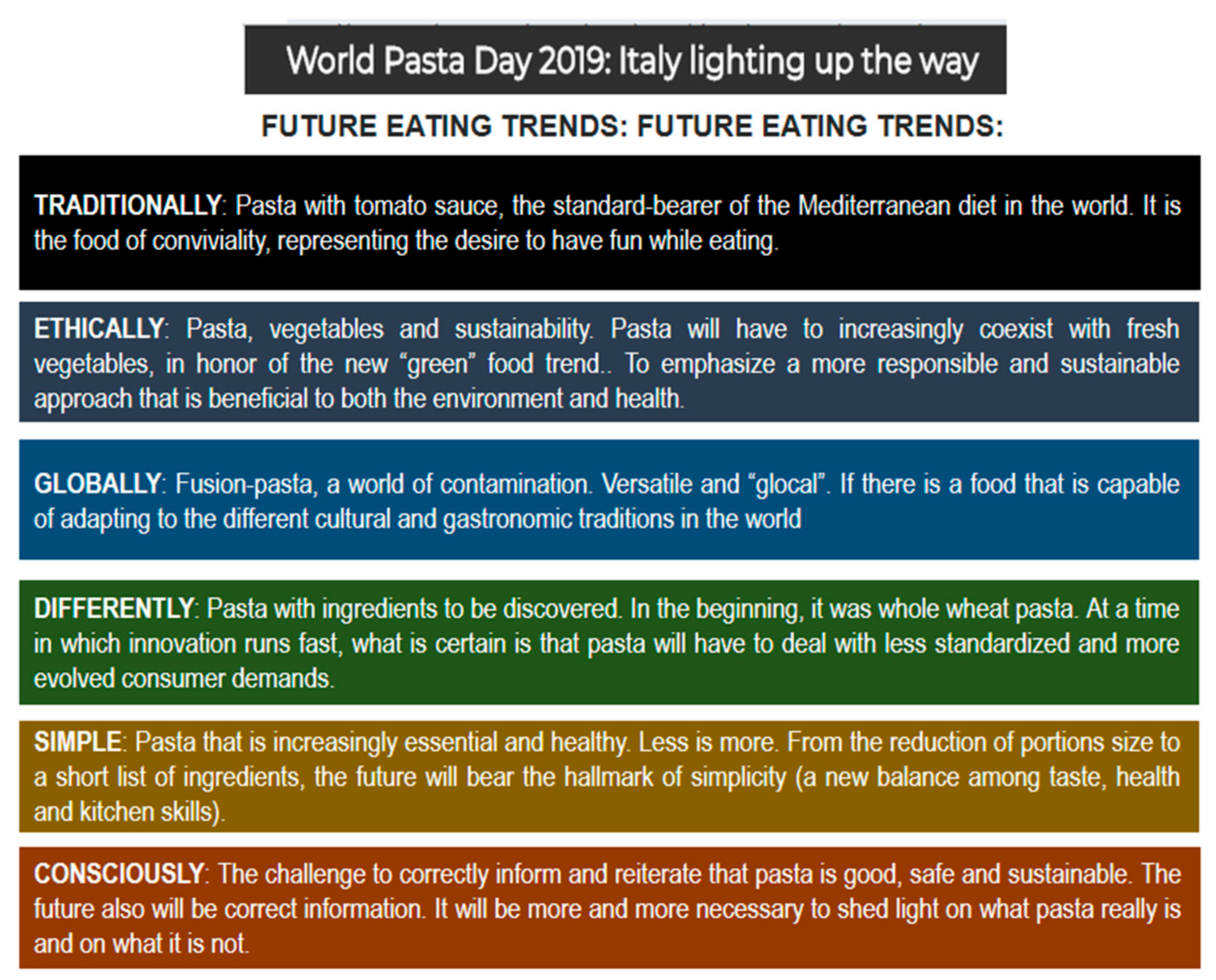
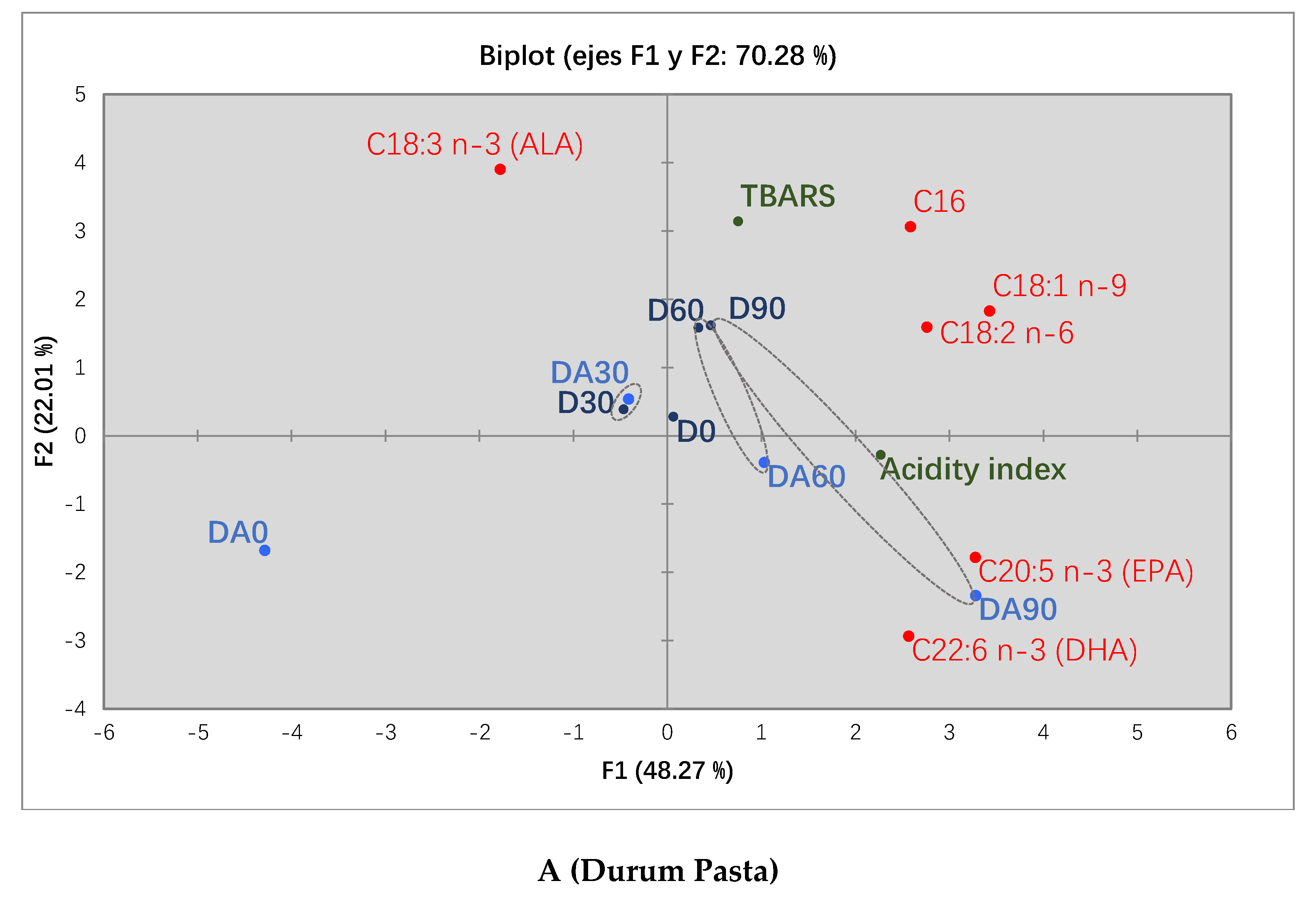
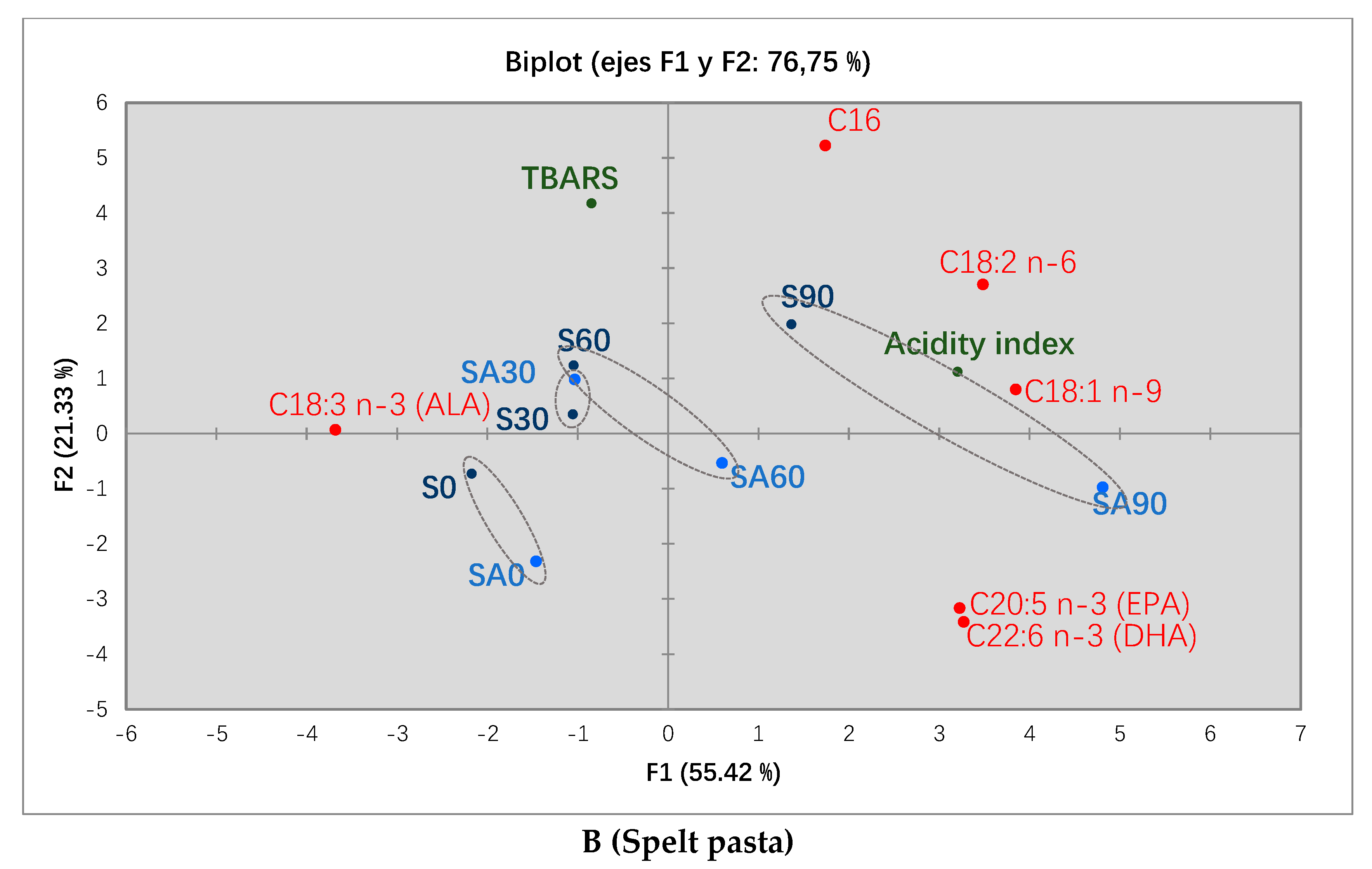
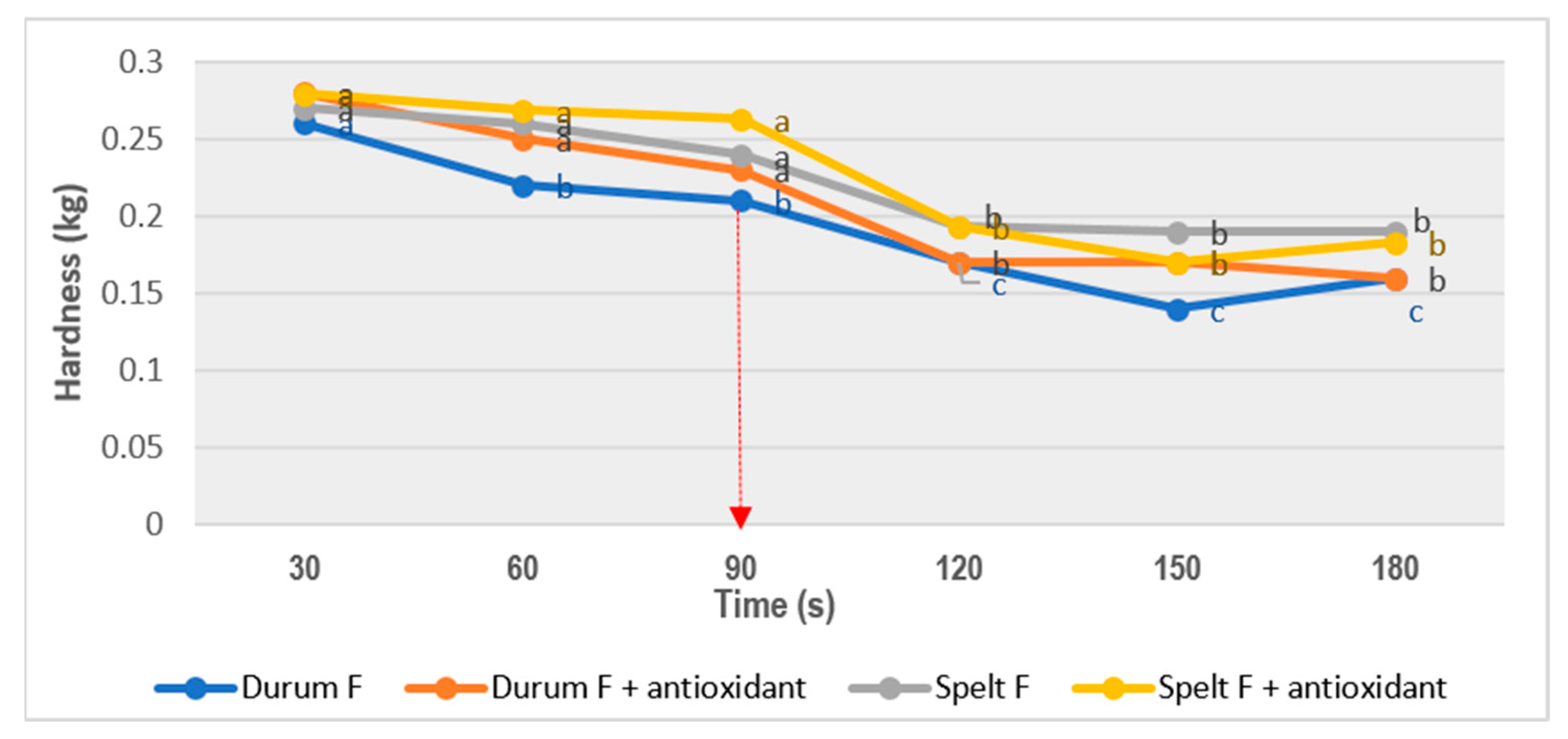

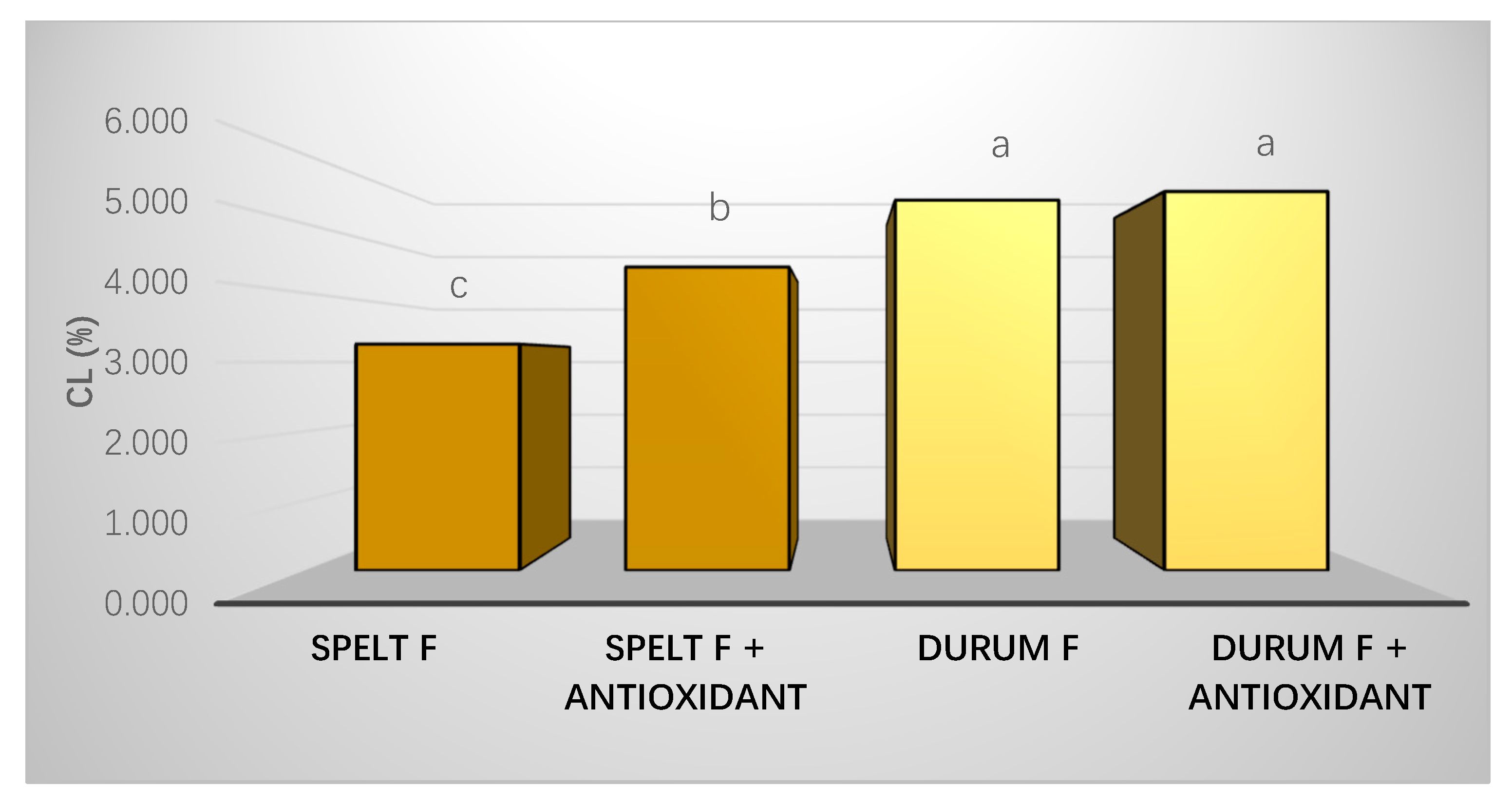

| Durum F | % | Durum F with Antioxidant | % | Spelt F | % | Spelt F with Antioxidant | % |
|---|---|---|---|---|---|---|---|
| Durum wheat | 64.5 | Durum wheat | 64.5 | Spelt wheat | 55 | Spelt wheat | 55 |
| Fish concentrate | 10 | Fish concentrate and antioxidant | 10 | Spelt bran | 10 | Spelt bran | 10 |
| Aromatic herbs and spices | 0.5 | Aromatic herbs and spices | 0.5 | Fish concentrate | 10 | Fish concentrate and antioxidant | 10 |
| Water | 25 | Water | 25 | Water | 25 | Water | 25 |
| Triticum durum | Triticum spelta | |
|---|---|---|
| Durum F | Spelt F | |
| Moisture | 9.50 ± 1.10 | 11.50 ± 1.01 |
| Fat | 2.89 ± 0.28 a | 4.80 ± 0.27 b |
| Protein | 19.60 ± 0.10 | 19.65 ± 0.09 |
| Fiber | 1.27 ± 0.21 a | 9.05 ± 0.35 b |
| Ash | 4.60 ± 0.10 c | 3.21 ± 0.43 a |
| Carbohydrates | 62.43 ± 0.23 b | 51.59 ± 0.09 a |
| Energy values (Kcal/100 g) | 352.95 ± 0.32 b | 328.15 ± 3.35 a |
| Storage Time | |||||
|---|---|---|---|---|---|
| Treatments | 0 | 30 | 60 | 90 | |
| Durum F | |||||
| C16:0 | 15.76 a B | 15.63 a B | 15.75 a B | 16.99 b B | |
| C18:1 n-9 | 25.24 ab C | 25.04 a B | 25.38 ab C | 25.71 b D | |
| C18:2 n-6 | 34.09 ab C | 34.10 ab C | 34.40 b C | 32.68 a B | |
| C18:3 n-3 (ALA) | 3.91 b B | 3.89 b B | 3.90 b B | 3.71 a B | |
| C20:5 n-3 (EPA) | 2.25 B | 2.23 B | 2.27 B | 2.23 B | |
| C22:6 n-3 (DHA) | 3.60 b D | 3.46 b C | 3.51 b C | 3.13 a A | |
| Durum F + Antioxidant | |||||
| C16:0 | 13.95 a A | 16.04 b B | 15.75 b B | 15.93 b C | |
| C18:1 n-9 | 22.11 a A | 24.93 b B | 25.29 c C | 26.06 d E | |
| C18:2 n-6 | 29.55 a A | 35.65 c D | 34.39 b C | 34.61 b C | |
| C18:3 n-3 (ALA) | 3.46 ab B | 3.92 b B | 4.03 b B | 1.40 a A | |
| C20:5 n-3 (EPA) | 2.08 a A | 2.24 b B | 2.47 c C | 2.53 c D | |
| C22:6 n-3 (DHA) | 3.25 a B | 3.47 b C | 4.16 c E | 4.23 c E | |
| 0 | 30 | 60 | 90 | ||
| Spelt F | |||||
| C16:0 | 14.02 A | 14.75 AB | 15.19 AB | 15.84 B | |
| C18:1 n-9 | 26.92 a A | 28.91 b B | 28.74 b B | 29.17 b B | |
| C18:2 n-6 | 31.06 a A | 33.90 b C | 34.29 b C | 35.42 c D | |
| C18:3 n-3 (ALA) | 3.58 b B | 3.80 b B | 3.83 b B | 1.56 a A | |
| C20:5 n-3 (EPA) | 1.92 A | 1.96 A | 1.87 A | 1.87 A | |
| C22:6 n-3 (DHA) | 2.45 A | 2.61 B | 2.43 A | 2.44 A | |
| Spelt F + Antioxidant | |||||
| C16:0 | 13.99 a A | 15.25 b AB | 15.40 b AB | 14.90 b AB | |
| C18:1 n-9 | 26.57 a A | 28.35 b B | 28.85 c B | 33.29 d C | |
| C18:2 n-6 | 30.29 a A | 32.46 b B | 32.41 b B | 37.72 c E | |
| C18:3 n-3 (ALA) | 3.42 b B | 3.69 b B | 1.91 ab A | 1.15 a A | |
| C20:5 n-3 (EPA) | 2.03 a B | 2.05 ab B | 2.13 b B | 2.48 c C | |
| C22:6 n-3 (DHA) | 2.84 a B | 2.64 a B | 2.74 a B | 3.66 b C | |
| Storage Time | |||||
|---|---|---|---|---|---|
| Treatments | 0 | 30 | 60 | 90 | |
| Durum F | |||||
| %SFA | 20.80 a A | 22.82 c B | 21.66 b B | 22.17 bc B | |
| %MUFA | 31.91 B | 31.61 B | 31.97 B | 32.76 B | |
| %PUFA | 46.32 b C | 45.58 b B | 46.28 b C | 44.14 a B | |
| P/S ratio | 2.23 c B | 2.00 a A | 2.14 b B | 1.99 a A | |
| ω6/ω3 ratio | 3.47 A | 3.51 A | 3.39 B | 3.45 A | |
| mg ω3/100 g | 241.20 c B | 240.01 c B | 212.27 b B | 178.55 a A | |
| TBARS | 1.13 a A | 1.14 a A | 1.70 c C | 1.28 b B | |
| Acidity Ind. | 0.16 | 0.15 | 0.16 | 0.17 | |
| AI | 0.31 a A | 0.31 a A | 0.31 a A | 0.34 b B | |
| TI | 0.49 a A | 0.49 a A | 0.49 a A | 0.54 b B | |
| Durum F + antioxidant | |||||
| %SFA | 23.19 c B | 21.22 b A | 20.71 a A | 20.96 a A | |
| %MUFA | 28.07 a A | 31.47 b B | 32.06 b B | 35.33 c C | |
| %PUFA | 40.41 a A | 47.31 c D | 47.18 c D | 43.71 b B | |
| P/S ratio | 1.74 a A | 2.23 b B | 2.28 b B | 2.09 b A | |
| ω6/ω3 ratio | 3.29 a A | 3.58 ab A | 3.13 a A | 4.71 b B | |
| mg ω3/100 g | 289.52 c B | 304.90 c C | 243.10 b B | 196.42 a A | |
| TBARS | 1.06 a A | 1.01 a A | 1.21 b B | 1.10 ab A | |
| Acidity Ind. | 0.14 a | 0.13 a | 0.14 a | 0.18 b | |
| AI | 0.32 A | 0.31 A | 0.31 A | 0.31 A | |
| TI | 0.50 A | 0.49 A | 0.49 A | 0.48 A | |
| Storage Time | |||||
|---|---|---|---|---|---|
| Treatments | 0 | 30 | 60 | 90 | |
| Spelt F | |||||
| %SFA | 19.34 A | 19.66 A | 20.29 B | 20.45 B | |
| %MUFA | 33.58 a A | 35.97 b B | 35.59 b B | 37.52 c C | |
| %PUFA | 40.84 a A | 44.37 b B | 44.09 b B | 42.53 ab B | |
| P/S ratio | 2.11 A | 2.26 B | 2.17 A | 2.08 A | |
| ω6/ω3 ratio | 3.74 a A | 3.87 a A | 4.13 b B | 6.49 c C | |
| mg ω3/100 g | 335.96 b B | 377.46 c B | 348.00 b B | 251.82 a A | |
| TBARS | 1.33 a B | 1.41 b B | 1.40 b B | 1.24 a A | |
| Acidity Ind. | 0.12 a | 0.10 a | 0.12 a | 0.21 b | |
| AI | 0.29 | 0.29 | 0.30 | 0.31 | |
| TI | 0.45 A | 0.44 A | 0.45 A | 0.44 A | |
| Spelt F + Antioxidant | |||||
| %SFA | 18.66 a A | 21.55 c | 20.59 b B | 18.67 a A | |
| %MUFA | 33.22 a A | 35.50 b B | 36.10 c B | 39.22 d C | |
| %PUFA | 41.00 A | 42.98 A | 41.51 A | 42.11 A | |
| P/S ratio | 2.20 b A | 1.99 a A | 2.02 a A | 2.26 b B | |
| ω6/ω3 ratio | 3.56 a A | 3.73 ab A | 4.50 ab B | 4.82 b B | |
| mg ω3/100 g | 391.34 a B | 377.41 a B | 392.57 a B | 459.51 b C | |
| TBARS | 0.95 a A | 1.05 a A | 0.99 a A | 1.23 b A | |
| Acidity Ind. | 0.13 a | 0.11 a | 0.13 a | 0.19 b | |
| AI | 0.30 b | 0.31 b | 0.31 b | 0.29 a | |
| TI | 0.46 b A | 0.47 b B | 0.46 b A | 0.42 a A | |
Publisher’s Note: MDPI stays neutral with regard to jurisdictional claims in published maps and institutional affiliations. |
© 2021 by the authors. Licensee MDPI, Basel, Switzerland. This article is an open access article distributed under the terms and conditions of the Creative Commons Attribution (CC BY) license (http://creativecommons.org/licenses/by/4.0/).
Share and Cite
Ainsa, A.; Marquina, P.L.; Roncalés, P.; Beltrán, J.A.; Calanche M., J.B. Enriched Fresh Pasta with a Sea Bass By-Product, a Novel Food: Fatty Acid Stability and Sensory Properties throughout Shelf Life. Foods 2021, 10, 255. https://doi.org/10.3390/foods10020255
Ainsa A, Marquina PL, Roncalés P, Beltrán JA, Calanche M. JB. Enriched Fresh Pasta with a Sea Bass By-Product, a Novel Food: Fatty Acid Stability and Sensory Properties throughout Shelf Life. Foods. 2021; 10(2):255. https://doi.org/10.3390/foods10020255
Chicago/Turabian StyleAinsa, Andrea, Pedro L. Marquina, Pedro Roncalés, José Antonio Beltrán, and Juan B. Calanche M. 2021. "Enriched Fresh Pasta with a Sea Bass By-Product, a Novel Food: Fatty Acid Stability and Sensory Properties throughout Shelf Life" Foods 10, no. 2: 255. https://doi.org/10.3390/foods10020255
APA StyleAinsa, A., Marquina, P. L., Roncalés, P., Beltrán, J. A., & Calanche M., J. B. (2021). Enriched Fresh Pasta with a Sea Bass By-Product, a Novel Food: Fatty Acid Stability and Sensory Properties throughout Shelf Life. Foods, 10(2), 255. https://doi.org/10.3390/foods10020255








